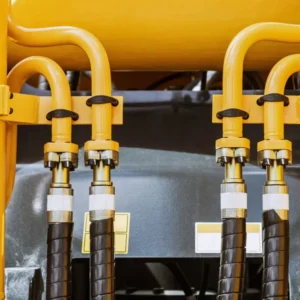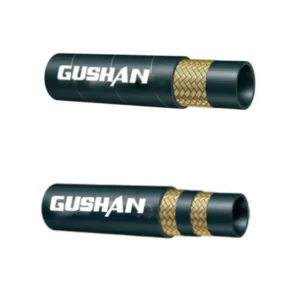Choosing the right material for fluid conveyance is vital for system safety and efficiency. This comparison explores the key differences between PTFE (Polytetrafluoroethylene) hose and traditional rubber hose, helping you determine which material is best suited for your specific application. We’ll examine performance, flexibility, temperature limits, and chemical compatibility.
Understanding the unique properties of each material—from rubber’s elasticity to PTFE’s extreme resilience—will guide your selection. Whether your project involves high pressure, corrosive chemicals, or stringent temperature requirements, knowing these distinctions ensures optimal system reliability and minimizes the risk of costly failures.
What is a PTFE Hose?
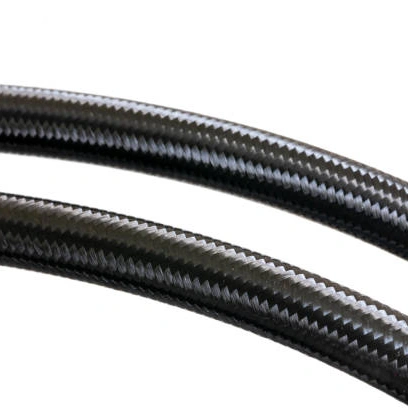
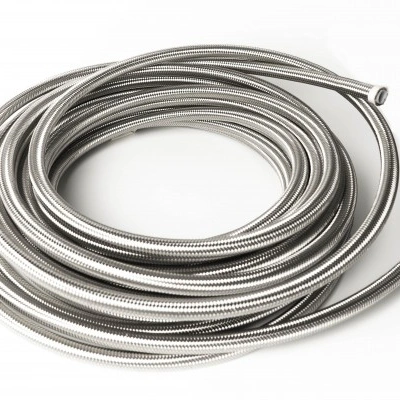
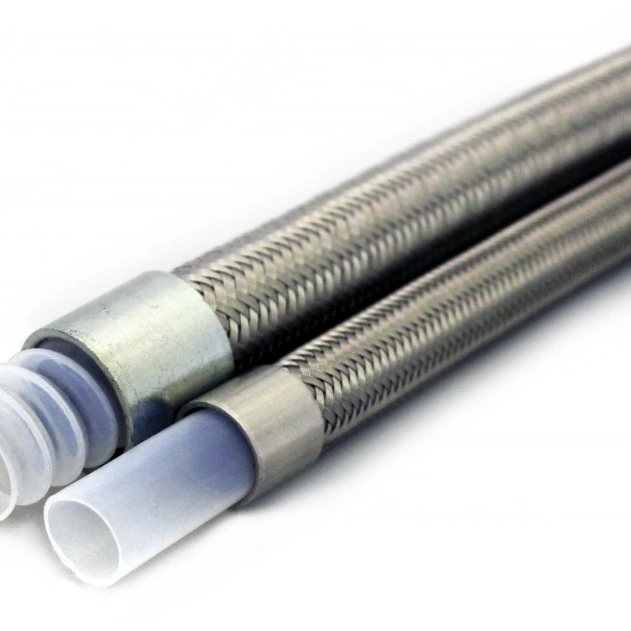
A PTFE Hose is a highly specialized industrial hose featuring a core tube made from Polytetrafluoroethylene, a synthetic fluoropolymer commonly known by the brand name Teflon™. This material is prized for being chemically inert and having the lowest coefficient of friction of any solid material. This unique combination makes it superior for use in severe service applications.
These hoses are typically reinforced with an external braid, often stainless steel, to manage high pressure and prevent kinking. PTFE hoses are essential in industries like automotive, chemical, and pharmaceutical, where extreme performance, purity, and resistance to degradation are absolutely critical for safe and reliable fluid transfer.
- Exceptional Chemical Resistance: PTFE is chemically inert, meaning it resists degradation from virtually all corrosive chemicals, strong acids, bases, and aggressive solvents. This property makes it an indispensable choice for safely transferring volatile or hazardous media that would quickly break down traditional rubber or plastic hoses.
- Extreme Temperature Tolerance: The hose can operate safely across an incredibly broad temperature spectrum, typically from cryogenic lows up to +260∘C (over +500∘F). This thermal stability allows for use in high-heat zones like engine bays and steam transfer lines without compromising structural integrity or performance.
- Non-Stick and Purity: Due to its ultra-low friction surface, PTFE is non-stick, which prevents material buildup and makes the hose self-cleaning and hygienic. This inert, non-toxic characteristic is mandatory for applications in the food, beverage, and pharmaceutical industries where maintaining fluid purity is paramount.
- High Pressure Capability: PTFE hoses are commonly jacketed with a high-strength outer braid, typically stainless steel, which enables them to handle very high operating pressures. This external reinforcement prevents the inner core from expanding, ensuring consistent flow rate and maintaining a high level of system safety.
What is a Rubber Hose?
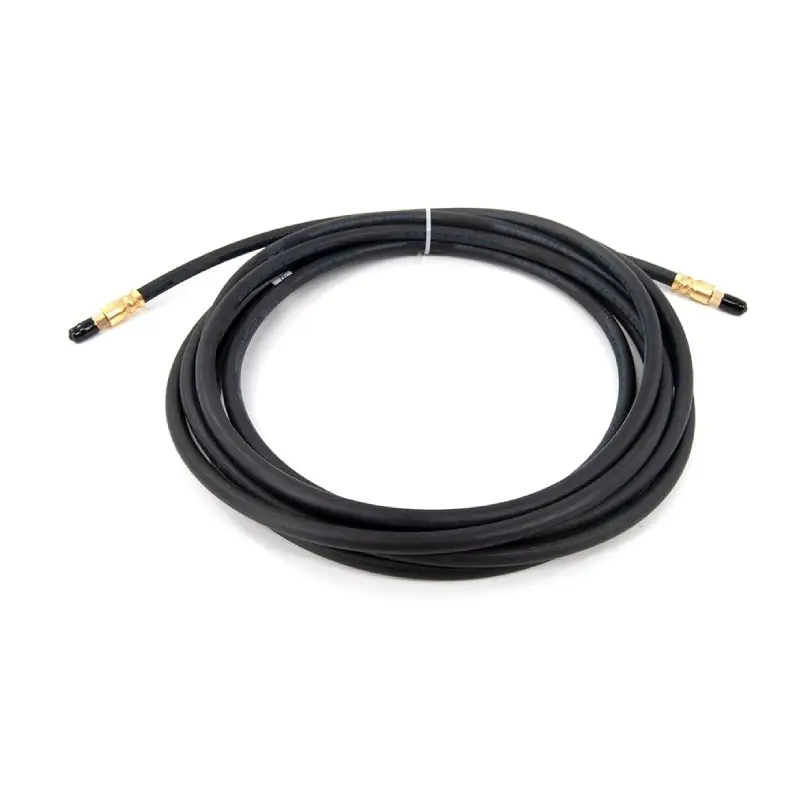
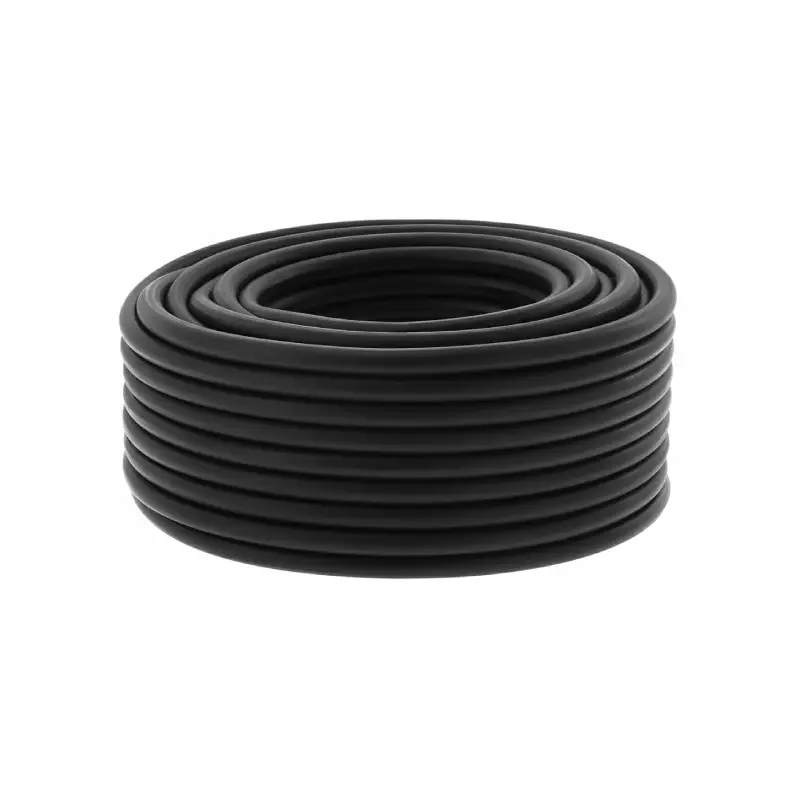
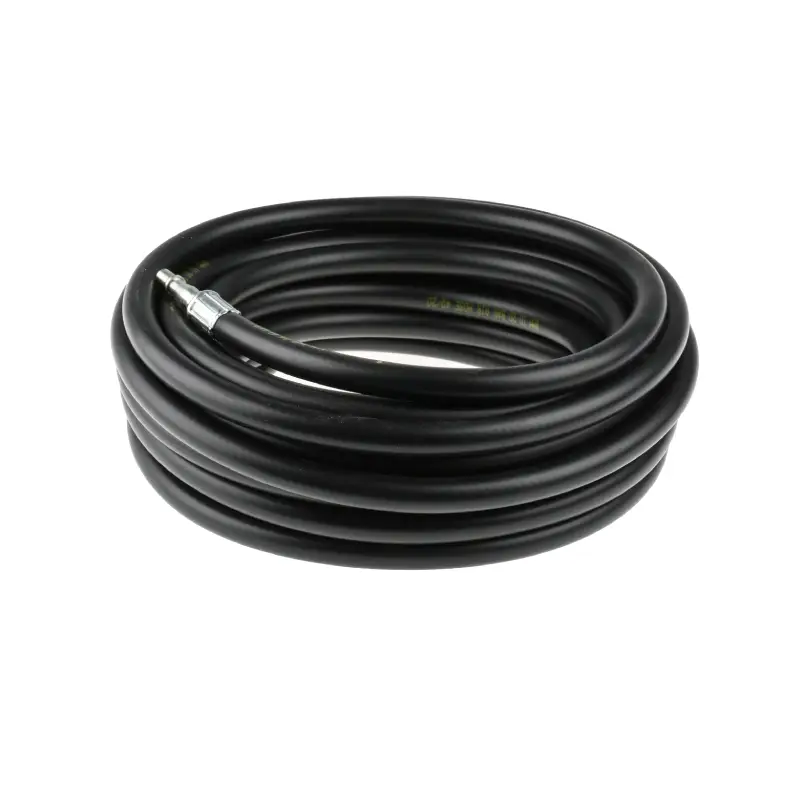
A Rubber Hose is a flexible, multi-layered tube primarily made from natural or synthetic rubber compounds, designed to transfer liquids, gases, or solids across various systems. The rubber construction provides superior elasticity, excellent vibration dampening, and resistance to abrasion. This makes rubber hoses the most common and versatile solution across industrial, automotive, and domestic applications worldwide.
The material composition, such as EPDM, NBR, or SBR, is carefully chosen based on the fluid being conveyed, ensuring resistance to oil, heat, or chemicals. Reinforced with textile or wire braiding, rubber hoses are engineered for reliability and long service life under both high pressure and demanding environmental conditions.
- Layered Construction A typical rubber hose features three distinct layers: an inner tube compatible with the fluid, a middle reinforcement layer (braid or spiral wire) for strength, and an outer cover that protects against abrasion, weather, and ozone. This construction ensures durability and pressure handling.
- Material Versatility Different synthetic rubber compounds are used to tailor the hose to the fluid: Nitrile (NBR) for fuel and oil resistance, EPDM for superior heat and weather resistance (like in cooling systems), and SBR for abrasion resistance in general industrial use.
- Flexibility and Vibration Dampening Rubber naturally offers high flexibility, allowing easy routing and connection in systems with moving parts or tight spaces. Crucially, the elastic nature of the material excels at absorbing shock and dampening system vibrations, protecting connected equipment and increasing system longevity.
- Wide Range of Applications From low-pressure garden watering and automotive coolant lines to high-pressure hydraulic systems in construction and air brakes in commercial vehicles, rubber hoses are applied extensively. They are the go-to choice for cost-effective, dependable fluid conveyance in general-purpose and heavy-duty environments.
PTFE Hose vs Rubber
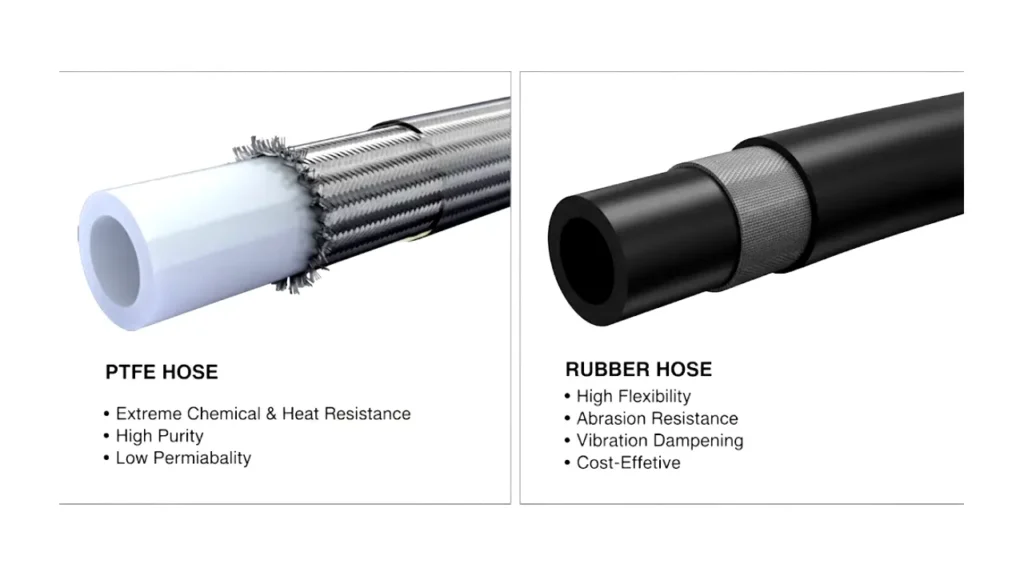
Fluid transfer applications require selecting the right material, and the choice often comes down to PTFE (Polytetrafluoroethylene) versus traditional rubber hoses. The differences in their core materials and construction lead to vastly different performance profiles, particularly concerning chemical compatibility and temperature range.
Understanding these distinctions is essential for engineers and users to ensure system longevity, prevent failures, and maintain the integrity of the media being conveyed in demanding industrial, automotive, or chemical environments.
Chemical Resistance
PTFE hoses offer virtually universal chemical resistance, being inert to almost all industrial chemicals, strong acids, bases, and aggressive solvents. This non-reactive nature means the hose liner will not degrade, contaminate the transferred fluid, or suffer from swelling or deterioration, providing unmatched reliability for corrosive media transfer.
In contrast, the chemical resistance of rubber hoses is highly dependent on the specific polymer used, such as Nitrile for oil, or EPDM for water. No single rubber type can handle the full spectrum of chemicals PTFE can, and exposure to incompatible fluids (like gasoline in a general-purpose hose) will lead to rapid degradation, softening, and eventual failure.
Temperature Range
PTFE hoses boast an extremely wide temperature operating range, typically functioning reliably from cryogenic temperatures up to $+260^\circ\text{C}$ (over $+500^\circ\text{F}$). This tolerance for extreme heat makes them suitable for high-temperature steam lines, engine applications, and hot oil transfer where rubber would quickly break down or become brittle.
Rubber hoses have a much more limited temperature tolerance, with even high-performance synthetic rubbers rarely exceeding $+150^\circ\text{C}$ $\left(+300^\circ\text{F}\right)$. At high temperatures, rubber can harden, lose flexibility, or soften and lose pressure rating, while at very low temperatures, it can become rigid and prone to cracking.
Flexibility and Kink Resistance
Rubber hoses are known for their inherent flexibility and elasticity, allowing for a tighter bend radius and easier routing around complex components. Their resilient nature allows them to absorb motion and vibration effectively, and standard industrial rubber hoses offer superior kink resistance compared to non-convoluted PTFE.
Smooth bore PTFE hoses are naturally stiffer due to the polymer’s structure, offering less flexibility and a larger minimum bend radius, which must be carefully observed during installation to avoid kinking. While convoluted PTFE hoses are available to improve flexibility, they often sacrifice some pressure rating and ease of cleaning compared to the smooth bore variety.
Non-Permeability and Purity
PTFE has extremely low permeability (low porosity), acting as an excellent vapor barrier that prevents fluids or gases from seeping through the hose wall. This is a critical advantage for fuel lines and high-purity applications, as it prevents odors from permeating and ensures the transported material remains uncontaminated.
Rubber, being a polymer, is inherently more porous than PTFE, making it more susceptible to gas and vapor permeation. While specialized rubber compounds exist to minimize this, rubber hoses generally cannot guarantee the same level of fluid purity and vapor containment required for highly sensitive medical, food-grade, or environmental applications.
Durability and Abrasion Resistance
When reinforced (typically with stainless steel braid), PTFE hoses offer exceptional long-term durability and resistance to environmental aging, ozone, and UV light. The non-stick surface also helps reduce wear from internal flow, but the outer metal braid can sometimes be susceptible to external damage and can abrade surrounding surfaces.
The thick, resilient outer cover of a standard industrial rubber hose provides excellent external abrasion resistance, protecting the internal reinforcement from external rubbing, dragging, and impact damage typical in construction or mining environments. However, rubber’s lifespan is still limited by natural aging and hardening over time due to environmental exposure.
Here are some differences between PTFE hoses and rubber hoses:
| Feature | PTFE Hose | Rubber Hose |
| Chemical Resistance | Excellent (Inert to almost all chemicals) | Varies (Specific compound required for fluid) |
| Temperature Range | Very Wide (Cryogenic up to $+260^\circ\text{C}$) | Limited (Typically up to $+150^\circ\text{C}$ max) |
| Flexibility | Lower (Stiffer, larger bend radius) | High (Flexible, absorbs vibration well) |
| Permeability | Extremely Low (Excellent vapor barrier/purity) | Higher (More prone to vapor seepage) |
| External Abrasion | Lower (Metal braid may abrade surrounding objects) | High (Thick rubber cover protects against dragging) |
PTFE vs Nitrile Rubber Hoses
PTFE (Polytetrafluoroethylene) Hoses
PTFE hoses represent the high-performance standard for extreme conditions, excelling where chemical inertness and high-temperature stability are critical. They are a fluoropolymer engineered to resist fuel permeation and chemical degradation, making them perfect for aggressive modern fuels, including ethanol blends. Their superior construction ensures a safer and longer-lasting fuel system.
- Chemical and Temperature Resistance PTFE is virtually chemically inert, offering exceptional resistance to almost all acids, bases, and aggressive solvents where rubber would degrade. They withstand an extreme temperature range, from cryogenic lows up to +260°C, making them an ideal and stable choice for aerospace or chemical processing components.
- Vapor Barrier and Weight The material’s non-permeable nature ensures that fuel vapors cannot leach through the hose wall. This is a crucial safety feature, making them the only recommended option for running fuel lines inside a vehicle’s cabin, eliminating hazardous odors. Additionally, they are typically lightweight.
- Assembly and Flexibility PTFE hoses are quick and easy to assemble using specialized, non-crimping hose fittings with minimal tools. However, they are inherently less flexible, possessing a significantly reduced bend radius compared to rubber, often requiring more angle fittings, which can offset the material’s initial cost savings.
Nitrile Rubber (NBR) Hoses
Nitrile Rubber (NBR) hoses are a common and cost-effective solution favored for general use in automotive and moderate industrial applications. This synthetic elastomer offers good resistance to common media like petroleum oils, fuels, and greases, combined with high elasticity and flexibility. NBR provides a balance of performance and affordability for everyday applications.
- Flexibility and Installation Ease NBR hoses are highly flexible, offering an excellent bend radius that makes them much easier to route and install in tight spaces without kinking. This flexibility allows for a desired system layout with fewer supplementary fittings and adapters, reducing both complexity and the potential for leaks at connection points.
- Chemical Compatibility and Permeation While suitable for oils and fuels, NBR is susceptible to degradation from strong acids, bases, ozone, and polar solvents like acetone. Crucially, NBR is permeable, allowing fuel vapors to pass through the hose wall over time, which means they should never be used inside a vehicle’s cabin.
- Fittings and Cost Nitrile hoses typically require a more specialized crimp-style hose fitting for secure assembly, which can be difficult and more time-consuming to install than PTFE fittings. Despite this assembly drawback, NBR remains a preferred choice for budget-conscious consumers due to its significantly lower initial material cost compared to PTFE.
How to Choose PTFE Hoses and Rubber Hoses?
Choosing between a PTFE (Polytetrafluoroethylene) hose and a rubber hose depends entirely on the operating conditions, media, and cost constraints of your system. The right selection is crucial to ensure fluid integrity, maximize system safety, and achieve the intended service life, as each material offers a distinct set of performance advantages and limitations.
To make an informed decision, you must rigorously evaluate the specific demands of your application against the inherent properties of the hose material. Prioritizing factors like temperature exposure, chemical corrosiveness, and flexibility will guide you toward the most appropriate and cost-effective hose solution.
- Determine Operating Temperature applications involving extreme temperatures (very high heat or cryogenic cold), PTFE is the superior choice due to its stability across a broad range (−73∘C to +260∘C). Rubber should only be selected for moderate temperatures, as excessive heat will cause it to harden, crack, or soften prematurely, leading to failure.
- Assess Chemical Compatibility: the fluid is a corrosive chemical, acid, base, or modern fuel (like E85), select PTFE because of its near-universal inertness and non-contaminating properties. If the fluid is a general-purpose medium like water, air, or standard petroleum oil, a specific, specialized rubber compound (like NBR or EPDM) is often sufficient and more economical.
- Evaluate Flexibility Needs: If the hose must navigate tight turns or frequently bend without kinking, choose a rubber hose or a convoluted PTFE hose, as rubber offers greater natural elasticity. If routing is straight and flexibility is secondary to chemical performance, a stiffer, smooth-bore PTFE hose provides better flow and cleanliness.
- Consider Pressure and Permeability: High-pressure hydraulic systems, both types are available with reinforcement (steel braid), but for applications requiring zero vapor permeability (like fuel lines that must not emit odors) or high-purity transfer, select PTFE. Rubber hoses are generally more susceptible to gas and vapor seepage over time.
- Analyze Cost and Abrasion: Cost is the main constraint and the operating conditions are mild, a durable rubber hose is typically the most economical choice. However, if the environment is heavily abrasive (like dragging across rough concrete), a rubber hose with a thick cover offers better external abrasion resistance than a metal-braided PTFE hose.
Conclusion
In conclusion, the primary distinction between PTFE and rubber hoses lies in their core strengths: PTFE offers unmatched chemical inertness and high-temperature tolerance, making it superior for aggressive media and extreme environments. Conversely, rubber excels in applications demanding high flexibility, excellent vibration damping, and a more cost-effective solution for general fluids and lower pressures.
Your final selection must be based on a thorough analysis of the medium being transferred, the operating temperature and pressure, and the required service life. While PTFE provides a premium, long-term solution against degradation, modern synthetic rubber compounds deliver robust performance suitable for the vast majority of standard industrial, automotive, and air conveyance needs.
For all your conventional fluid transfer requirements, we at Gushan Rubber offer a comprehensive selection of wholesale rubber hoses. Our products are manufactured to stringent quality standards, ensuring durability, reliability, and competitive pricing for bulk orders. Contact us to get the right hose for your application today.

